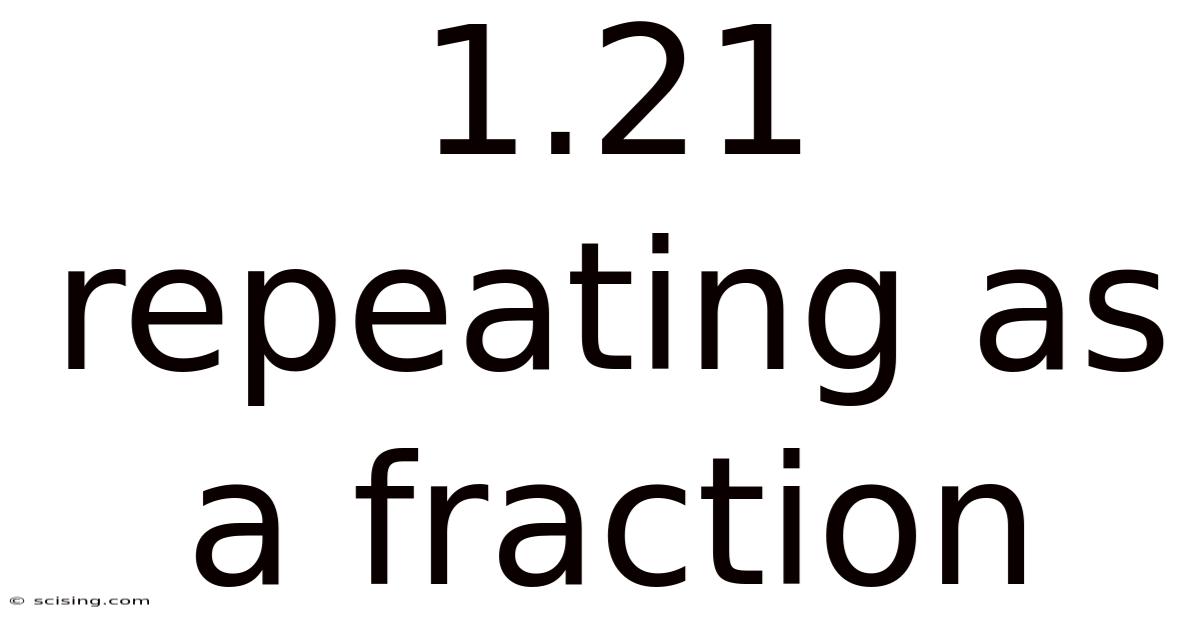1.21 Repeating As A Fraction
scising
Sep 23, 2025 · 5 min read

Table of Contents
Unlocking the Mystery: 1.212121... as a Fraction
The seemingly simple decimal 1.212121... (or 1.$\overline{21}$) presents a fascinating puzzle: how do we express this repeating decimal as a fraction? This seemingly straightforward question opens the door to a deeper understanding of decimal representation, number systems, and algebraic manipulation. This article will guide you through the process of converting repeating decimals into fractions, focusing specifically on 1.212121..., and then extend the understanding to other repeating decimals. By the end, you'll not only know the fractional equivalent of 1.212121... but also possess the tools to tackle similar problems confidently.
Understanding Repeating Decimals
Before diving into the solution, let's clarify what a repeating decimal is. A repeating decimal is a decimal number where one or more digits repeat infinitely. We denote repeating digits by placing a bar over them. For example:
- 0.3333... is written as 0.$\overline{3}$
- 0.142857142857... is written as 0.$\overline{142857}$
- And our focus, 1.212121..., is written as 1.$\overline{21}$
The repeating part is crucial; it distinguishes these numbers from terminating decimals (like 0.25 or 0.75) which have a finite number of digits after the decimal point. Repeating decimals represent rational numbers—numbers that can be expressed as a fraction of two integers.
Converting 1.212121... to a Fraction: The Algebraic Approach
The key to converting a repeating decimal to a fraction lies in algebraic manipulation. Here's a step-by-step process for converting 1.$\overline{21}$:
Step 1: Assign a Variable
Let's represent the repeating decimal with a variable, say x:
x = 1.212121...
Step 2: Multiply to Shift the Decimal Point
We need to manipulate the equation to eliminate the repeating part. Since the repeating block "21" has two digits, we'll multiply both sides of the equation by 100:
100x = 121.212121...
Step 3: Subtract the Original Equation
Now, subtract the original equation (x = 1.212121...) from the equation obtained in Step 2 (100x = 121.212121...):
100x - x = 121.212121... - 1.212121...
This cleverly eliminates the repeating decimal part:
99x = 120
Step 4: Solve for x
Now, we can easily solve for x by dividing both sides by 99:
x = 120/99
Step 5: Simplify the Fraction
Finally, we simplify the fraction by finding the greatest common divisor (GCD) of 120 and 99. The GCD of 120 and 99 is 3. Dividing both the numerator and denominator by 3 gives us:
x = 40/33
Therefore, 1.212121... is equal to 40/33.
A Deeper Dive: The Underlying Mathematics
The method employed above works because we're essentially exploiting the properties of infinite geometric series. A repeating decimal can be represented as the sum of an infinite geometric series. Let's illustrate this with 1.$\overline{21}$:
1.$\overline{21}$ = 1 + 0.21 + 0.0021 + 0.000021 + ...
This is a geometric series with:
- First term (a) = 0.21
- Common ratio (r) = 0.01
The sum of an infinite geometric series is given by the formula: S = a / (1 - r), provided that |r| < 1. In our case:
S = 0.21 / (1 - 0.01) = 0.21 / 0.99 = 21/99 = 7/33
Remember that our original number was 1.$\overline{21}$, so we add the integer part:
1 + 7/33 = 33/33 + 7/33 = 40/33
This confirms our result obtained through the algebraic method.
Generalizing the Method: Tackling Other Repeating Decimals
The algebraic method demonstrated above can be applied to any repeating decimal. The key is to multiply by a power of 10 that shifts the decimal point to align the repeating block.
Example 1: Converting 0.$\overline{3}$ to a fraction
- Let x = 0.3333...
- Multiply by 10: 10x = 3.3333...
- Subtract: 10x - x = 3.3333... - 0.3333... => 9x = 3
- Solve: x = 3/9 = 1/3
Example 2: Converting 0.$\overline{142857}$ to a fraction
- Let x = 0.142857142857...
- Multiply by 1,000,000: 1000000x = 142857.142857...
- Subtract: 999999x = 142857
- Solve: x = 142857/999999 = 1/7
Frequently Asked Questions (FAQ)
Q1: What if the repeating decimal has a non-repeating part before the repeating block?
A: You still use the same approach. For example, to convert 2.3$\overline{14}$, you would let x = 2.3141414... and then multiply by 100 to align the repeating block. Remember to adjust the subtraction accordingly.
Q2: Can all repeating decimals be expressed as fractions?
A: Yes! This is the defining characteristic of rational numbers. Repeating decimals are a subset of rational numbers.
Q3: What if the repeating block has more than one digit?
A: The same method applies. Multiply by 10 raised to the power of the number of digits in the repeating block. For instance, if the repeating block has three digits, multiply by 1000.
Q4: Are there any limitations to this method?
A: The method is generally effective for most repeating decimals. However, exceptionally complex repeating blocks might lead to large fractions that require further simplification. But the fundamental principle remains the same.
Conclusion
Converting repeating decimals to fractions might seem daunting initially, but with the understanding of the algebraic method and the underlying principles of geometric series, it becomes a straightforward process. The techniques explained in this article provide you with the practical tools and mathematical understanding to tackle various repeating decimal-to-fraction conversions confidently. Remember, each step builds upon the previous one, so understanding each stage is crucial for mastering this important mathematical skill. By applying these steps systematically, you'll unlock the secrets behind those seemingly infinite numbers and express them in their simplest fractional form. The ability to convert repeating decimals to fractions not only enhances your mathematical abilities but also deepens your understanding of number systems and their interrelationships.
Latest Posts
Related Post
Thank you for visiting our website which covers about 1.21 Repeating As A Fraction . We hope the information provided has been useful to you. Feel free to contact us if you have any questions or need further assistance. See you next time and don't miss to bookmark.